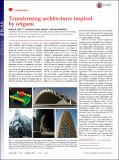| dc.contributor.author | Reis, Pedro Miguel | |
| dc.contributor.author | Lopez Jimenez, Francisco | |
| dc.contributor.author | Marthelot, Joel Genet Augustin | |
| dc.date.accessioned | 2016-04-04T15:51:55Z | |
| dc.date.available | 2016-04-04T15:51:55Z | |
| dc.date.issued | 2015-10 | |
| dc.identifier.issn | 0027-8424 | |
| dc.identifier.issn | 1091-6490 | |
| dc.identifier.uri | http://hdl.handle.net/1721.1/102098 | |
| dc.description.abstract | Paper folding is found across cultures for both aesthetic and functional purposes, with its most widely recognized exponent being the ancient art form of origami. More recently, there has been an upsurge of interest for translating origami designs into mathematics, natural sciences, engineering, and architecture. Across these different fields, origami is becoming a fountain of inspiration for new reconfigurable and multifunctional materials and structures. However, the use of origami designs as engineering elements is typically compromised by limitations in structural performance. A new study by Filipov et al. (1) presents an innovative approach for the design of strikingly rigid deployable structures. Their strategy is based on tubular building blocks, which are themselves built on Miura-ori; a regular folding pattern that maps a flat sheet into a one degree-of-freedom deployable structure (2). Two neighboring Miura tubes can be set in a zig-zag (“zipper”) arrangement; together, the pair is remarkably stiff and effectively possesses a single degree of freedom by resisting other bending and twisting modes. These zipper tubes can then be combined to generate other structures, including more complex tubular systems and cellular assemblies. In Fig. 1 A and B, we present two particular examples from their study: a model bridge with load-bearing capacity and an architectural canopy that can be deployed to cover a wide span. Filipov et al. (1) borrow well-established tools from structural mechanics that are commonly used in civil and mechanical engineering and port them to this new emerging field of origami-inspired design. | en_US |
| dc.language.iso | en_US | |
| dc.publisher | National Academy of Sciences (U.S.) | en_US |
| dc.relation.isversionof | http://dx.doi.org/10.1073/pnas.1516974112 | en_US |
| dc.rights | Article is made available in accordance with the publisher's policy and may be subject to US copyright law. Please refer to the publisher's site for terms of use. | en_US |
| dc.source | National Academy of Sciences (U.S.) | en_US |
| dc.title | Transforming architectures inspired by origami | en_US |
| dc.type | Article | en_US |
| dc.identifier.citation | Reis, Pedro M., Francisco Lopez Jimenez, and Joel Marthelot. “Transforming Architectures Inspired by Origami.” Proc Natl Acad Sci USA 112, no. 40 (September 23, 2015): 12234–12235. | en_US |
| dc.contributor.department | Massachusetts Institute of Technology. Department of Civil and Environmental Engineering | en_US |
| dc.contributor.department | Massachusetts Institute of Technology. Department of Mechanical Engineering | en_US |
| dc.contributor.mitauthor | Reis, Pedro Miguel | en_US |
| dc.contributor.mitauthor | Lopez Jimenez, Francisco | en_US |
| dc.contributor.mitauthor | Marthelot, Joel Genet Augustin | en_US |
| dc.relation.journal | Proceedings of the National Academy of Sciences | en_US |
| dc.eprint.version | Final published version | en_US |
| dc.type.uri | http://purl.org/eprint/type/JournalArticle | en_US |
| eprint.status | http://purl.org/eprint/status/PeerReviewed | en_US |
| dspace.orderedauthors | Reis, Pedro M.; Lopez Jimenez, Francisco; Marthelot, Joel | en_US |
| dc.identifier.orcid | https://orcid.org/0000-0003-3984-828X | |
| dc.identifier.orcid | https://orcid.org/0000-0001-8569-5400 | |
| dc.identifier.orcid | https://orcid.org/0000-0002-8682-9535 | |
| mit.license | PUBLISHER_POLICY | en_US |
| mit.metadata.status | Complete | |
